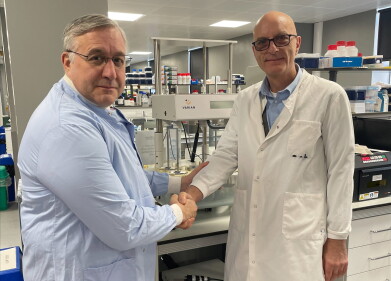-
 The Correlated Imaging Team with the new microscope. Pictured left to right: Dr Emanuela Liberti, Dr Chen Huang and Professor Angus Kirkland
The Correlated Imaging Team with the new microscope. Pictured left to right: Dr Emanuela Liberti, Dr Chen Huang and Professor Angus Kirkland -
 Judy Kim and Angus Kirkland
Judy Kim and Angus Kirkland
News
Can high speed EM be used on biological samples?
Jun 21 2021
Technique adapted to enable fast imaging speeds that “record data at close to a million frames a second, which will reduce the radiation damage visible on the sample.” Judy Kim
An electron microscope that can image biological samples at up to a million frames a second arrived at the Rosalind Franklin Institute on the Harwell Campus early in June. Shipped directly from Japan and the first of three instruments being developed jointly with JEOL Ltd., it will work with biological samples both cryogenically frozen and in liquids, which will enable imaging of molecules in motion.
Imaging molecular interaction
By using speeds more commonly associated with imaging semi-conductors or catalysts (a thousand times faster than the current standard for biological samples) in combination with liquid cells the Correlated Imaging Team will use the Ruska microscope to ‘film’ proteins as they fold or to image drugs interacting with other molecules. For cryogenically frozen samples, the frames captured as the beam passes through the sample will enable the creation of 3D models of biological structures, such as viruses or proteins.
Correlated Imaging Deputy Director, Dr Judy Kim said: “We’ve already shown in initial experiments that we can use this technique to look at biological material. But the machine we were using wasn’t optimised for these kinds of samples. With the new machines, we’ll be able to refine the technique further. We’ll also be able to run very fast, to record data at close to a million frames a second, which will reduce the radiation damage visible on the sample.”
Environmentally controlled location essential.
The machine, which will be located in a specialist EM suite minimising vibration, magnetic fields and acoustic noise and is also very carefully temperature controlled was amongst the first of equipment installations at the Rosalind Franklin building that will open fully later this year.
Correlated Imaging Director, Professor Angus Kirkland explained: “We’re looking at features that are smaller than the wavelength of normal visible light, so even tiny vibrations or changes in temperature can cause things to move. The machines have to be in a tightly controlled environment, so when we operate them, which we do remotely, there’s no risk of environmental interference.”
“The last five years have been very much about designing the instruments and building the platforms. But the next five years is about using those to do some really exciting science. We can’t wait to get started.”
Further information online
Digital Edition
ILM 50.2 March 2025
March 2025
Chromatography Articles - Effects of small deviations in flow rate on GPC/SEC results Mass Spectrometry & Spectroscopy Articles - Waiting for the present to catch up to the future: A bette...
View all digital editions
Events
Mar 18 2025 Beijing, China
Mar 20 2025 Brussels, Belgium
Mar 20 2025 Chandigarh, India
ACS National Meeting & Expo, Spring 2025
Mar 23 2025 San Diego, CA, USA
Mar 25 2025 Paris, France




















